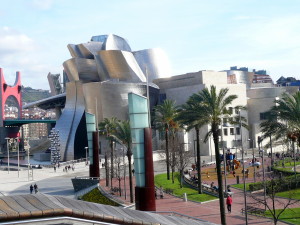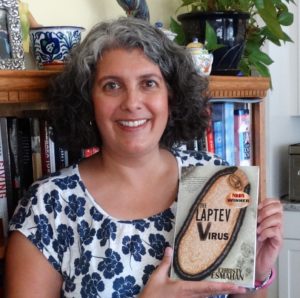The first time I went to Bilbao, a city of about 800,000, nestled in a valley between Basque mountain ranges, and only a few short miles from the Bay of Biscay, I was horrified to see that the huge river running through the middle of the city actually turned colors at different times of the day: it would go from steel gray to milky white to muddy brown, and several shades in between.
“It’s the paper mills, upstream,” my friend explained. “Their waste is unfiltered and dumped by the tons into the river. Nothing can live there.”
Not only did the unfortunate river change colors, but it stank as well, as most of the ancient city did not have sewage treatment plants. Bilbao, it was obvious, was no tourist jewel. It had been an industrial city for decades, faring better than many other cities during WWII as it was rich in iron ore and had provided tons of material to the English to build their battle ships. But now, the river banks were lined with dozens of shipyard cranes, and kilometers of railroad tracks scarred the adjacent terrain, while hundreds of abandoned railroad cars were piled haphazardly, rusting away in ignobility.
It was 1986 and at that time my plan was to spend just a few more months in Spain, then return to the U.S. to carry on with my life. I had no idea how deeply I would put down roots in that subfuscous city. But then, how much do any of us know at 22, when everything seems so clear and obvious?
I digress. The good news is that Bilbao changed. In 1989, amidst hundreds of cries of “This is the biggest waste of money ever!” the city began constructing a subway system. Old men, dressed in dark colored pants that were perfectly ironed, shiny leather shoes, and stiffly starched shirts, gathered in droves on the edges of the construction sites, just outside the security fences, and yelled instructions to the bulldozer and steam shovel operators who were blissfully oblivious in the raucous noise of concrete being torn up like Play-Doh.
It was a massive project. Traffic patterns in the heart of the city had to be shifted, the entrance to the Opera House was blocked for entire seasons, and a couple of huge, centenarian trees were carefully removed from a large central park for safe-keeping for several years while construction advanced at seemingly a snail’s pace. I got married, finished my degree, my son was born, we moved away from Bilbao, we moved back to Bilbao, and still, construction of the subway system continued. Finally, on 11/11/1995, at 11:11am, the metro opened for business. What an exciting day that was! Hundreds of people flocked to the terminals to take a ride and see what it was like. And I can tell you that it was beautiful!
Fast forward several more years and the city planners proved to be very savvy. The metro lines grew and to this day, they are still widely and heavily used, and have contributed greatly to the improvement in air quality as the number of vehicles in circulation on the city streets dropped dramatically.
The next steps that the Bilbao city planners took were also bold. They put in a bid for the new Guggenheim Museum, and won. I was fortunate enough to live only a ten minute walk away and had the wonderful opportunity to watch it being built. All but one of the shipyard cranes were removed, the railroad cars were hauled away and new parks and other museums were built on this recovered land.
And the poor river, you might be wondering? Yes, that has a happy ending too. One by one, the 15 paper mills were shut down, and then water treatment plants for city waste were put in. By the late 1990’s the water was back to being just one color, and in 2003, I looked down at the water from one of the new pedestrian bridges that had been built (since there were no longer large ships moving to and from the port as there had been for decades) and I saw large schools of fish swimming around in the clear waters. It was a poignant sight!
In my novel, some of my characters take a bus from Santander to Bilbao to tour this now lovely metropolis. They see the stunning glass mural at the train station, visit the fantastically whimsical Guggenheim Museum and are generally very impressed with this gem of a city. I loved being able to write that scene and knowing how lucky they were to be able to see such a cool place! Next time you’re in Spain, head north and see for yourself!
If you enjoyed this blog post, you might also like my series of novels, Bueno, Sinco and Brujas, which takes place in Santander, Spain.




2 pings
[…] where my novel is set, one about the Guggenheim Museum and one about the city of Bilbao ( and https://christyesmahan.com/?p=374) where I lived for six years and a place my characters visit, one on an embarrassing adventure I […]
[…] « Bilbao […]